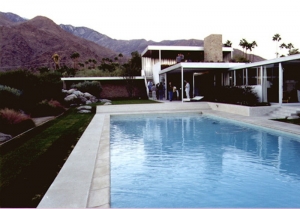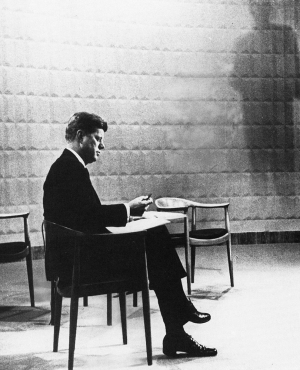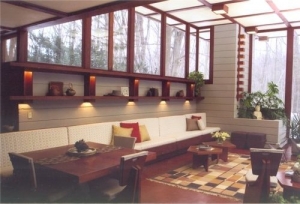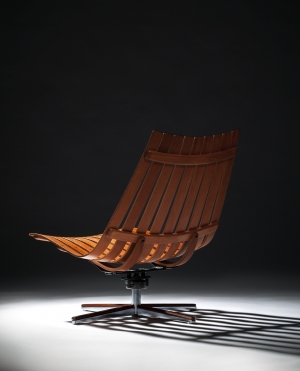|
Displaying items by tag: midcentury modern
1. How about Richard and Dion Neutra’s architectural masterpiece?
Designed by the seminal Modernist architect Richard Neutra and his son, Dion, this serene residence blends seamlessly with its surroundings. Built in Los Angeles’ Tarzana neighborhood in 1972, the architectural gem sits atop a nearly 3-acre expanse of land, providing 360-degree views of the stunning San Fernando Valley. The 5,500-square-foot estate features four bedrooms, vast walls of glass, and a luxurious outdoor area complete with a swimmer’s pool, a hot tub, and unique designer water features that surround the home’s exterior.
Will Orpheus return from the underworld this time? Will Apollo ever glitter again in sunlight? Is it possible that one of the largest works of public art in New York — a five-ton, 190-foot-long, 39-foot-high sculpture — could disappear with few people noticing?
Twenty-one months have passed since Lincoln Center announced that Richard Lippold’s monumental sculpture “Orpheus and Apollo” — a midcentury Modern explosion of polished metal strips that floated, with the help of some 450 steel wires, for more than 50 years over the grand foyer of what was first called Philharmonic Hall and then Avery Fisher Hall — was being “removed temporarily for maintenance and conservation.”
Modern art, architecture and decorative arts created in the middle of the 20th century were swamped by the reactionary ruckus of the late 20th century post-modernist movement.
Given the quality and originality of so much of the mid-century’s aesthetic industry, its relegation to obscurity was a big mistake and a now recognized lapse of taste. However, all wasn’t lost.
Mary Foley and Michael Cox, principals of the New York-based firm Foley & Cox Interiors, have been designing sumptuous spaces, both domestically and abroad, for over fifteen years. From stately residential projects to yachts and private aircraft interiors, Foley & Cox creates distinctive spaces that are incredibly elegant yet approachable. Recognized for its style and versatility, the firm believes that working closely with clients -- taking cues from their perceptions, preferences, and passions -- is the key to creating comfortably luxurious living environments. Because these bespoke interiors are infused with the client’s own personality, tastes, and style, they instantly become the most personal of places -- home.
Mary and Michael both possess a wealth of knowledge when it comes to furniture design, customized color palettes, and interior architecture.
Visit InCollect to learn more about Foley & Cox's favorite fine art, decorative objects, and
Few individuals have had as profound an effect on American furniture design as Paul Evans (1931-1987). A leading figure in the midcentury American studio furniture movement, Evans consistently pushed boundaries with his innovative approaches to metalsmithing and furniture-making. His transcendent works, which defied what everyday objects looked like and how they were made, continue to reveal the fascinating crosscurrents between sculpture and design.
Evans began working with metal in the early 1950s -- first at the Rochester Institute of Technology’s School for American Craftsmen (SAC) in Rochester, New York, where he studied under the influential American silversmiths and designers John (Jack) Prip and Lawrence Copeland, and later at the Cranbrook Academy of Art in Bloomfield Hills, Michigan.

On February 12, 2015, Modernism Week -- a multifaceted event aimed at celebrating and fostering appreciation of midcentury modern architecture, art, and design -- will begin in Palm Springs, California. Launched in 2006 by a group of local design and architecture aficionados, Modernism Week has grown to include over 100 events. Among the exhibitions, home tours, film screenings, and lectures, is Modernism Week’s catalyst -- the Palm Springs Modernism Show and Sale.
Now in its fifteenth year, the Palm Springs Modernism Show and Sale will be held from February 13-16, 2015, at the Palm Springs Convention Center. The show will feature 85 national and international dealers offering everything from furniture and jewelry to fine and decorative arts. Exhibitors will offer works representing all art and design movements of the twentieth century, but a special emphasis will be placed on midcentury modern. A preview reception on February 13, 2015, will give collectors and enthusiasts the chance to browse and shop the show before it opens to the public on February 14, 2015. Two dealers to look for at the show are Archive of Laguna Hills, California, and Bridges Over Time of Newburgh, New York.
The Palm Springs Art Museum announced that it will unveil its new Architecture and Design Center on November 9. The Edwards Harris Pavilion will be the hub of the museum’s exploration of architecture and design, and will feature spaces for exhibitions, educational and community programs, and research. The 13,000-square-foot building will also include a museum shop, curatorial offices, and a storage area.
The Architecture and Design Center is located in a restored mid-century Modern bank in downtown Palm Springs. The structure was designed in 1961 by the celebrated architect E. Stewart Williams to be the Santa Fe Federal Savings & Loan building and was recently designated as a protected Class I Historic Site. The Architecture and Design Center’s inaugural exhibition, “An Eloquent Modernist, E. Stewart Williams, Architect,” will explore Williams’ contributions to Desert Modern style as well as the Coachella Valley’s architectural landscape.

The Nordic Heritage Museum in Seattle, Washington, is celebrating the classic elegance of Scandinavian mid-century design with the exhibition “Danish Modern: Design for Living.” Organized by The Museum of Danish America in Elk Horn, Iowa, “Danish Modern” features simple and sophisticated furnishings designed and crafted in Denmark in the 1950s and 1960s -- a particularly prosperous period for the style.
The exhibition includes household items such as toys, lamps, and serving pieces, as well as a swath of chairs. Celebrated for its form, function, and consideration for the human body, it’s no surprise that a plethora of iconic chairs originated during the heyday of Danish Modern design. The show at the Nordic Heritage Museum features Arne Jacobsen’s cocoon-like “Egg” chair, graceful “Swan” Chair, and stackable “Seven" chair as well as Helge Sibast’s spindly “No. 8” chair and Hans Wegner’s curvaceous “Round” chair, which was so popular during the middle of the 20th century that it became known simply as “the Chair.”

One of the nine Usonian homes built in Ohio by the celebrated American architect Frank Lloyd Wright has just been put on the market. Located in Willoughby Hills, the 1,800-square-foot Louis Penfield House comes with two cottages on nearly 19 acres of land and carries a price tag of $1.7 million. Completed in 1955, the house was commissioned by Louis Penfield, a high school art teacher.
Wright began designing his Usonian homes in 1936. The houses, which erred on the smaller side, were made with middle-income families in mind. The homes were typically one story, flat-roofed dwellings without a garage and little storage space. The abodes usually featured overhangs or carports (a term coined by Wright) to protect parked vehicles. Wright’s Usonian houses were constructed using native materials and featured a strong visual connection between exterior and interior spaces. In total, Wright created around sixty Usonian homes, which served as the predecessor for the ranch-style houses that dominated residential architecture during the 1950s.

After successful stints in Oslo and Tokyo, “Norwegian Icons: Important Norwegian Design” is on view in New York City. The exhibition, which is currently taking place at the Openhouse Gallery in SoHo, explores Norway’s contributions to mid-century Scandinavian design. The show includes high-end decorative arts and furniture created between 1940 and 1975 as well as works by Norwegian artists, including Edvard Munch.
Mid-century Scandinavian design is well-known for its clean, simple lines and high functionality. However, there is often little distinction made between the contributions made by each country. While most design enthusiasts are familiar with Arne Jacobsen’s egg chair (Denmark) and Maija Isola’s bold, colorful textiles for Marimekko (Finland), Norway’s contributions to mid-century design often fly under the radar. Organized by Blomqvist, an Oslo-based auction house, and Fuglen, a Norwegian cafe/bar/vintage design shop, “Norwegian Icons” aims to educate the public about Norway’s contributions to Scandinavian design, including Hans Brattrud’s development of Alvar Aalto’s wood-bending technique and Sven Ivar Dysthe’s flat-packed, ready-to-ship furniture.
|
|
|
|
|